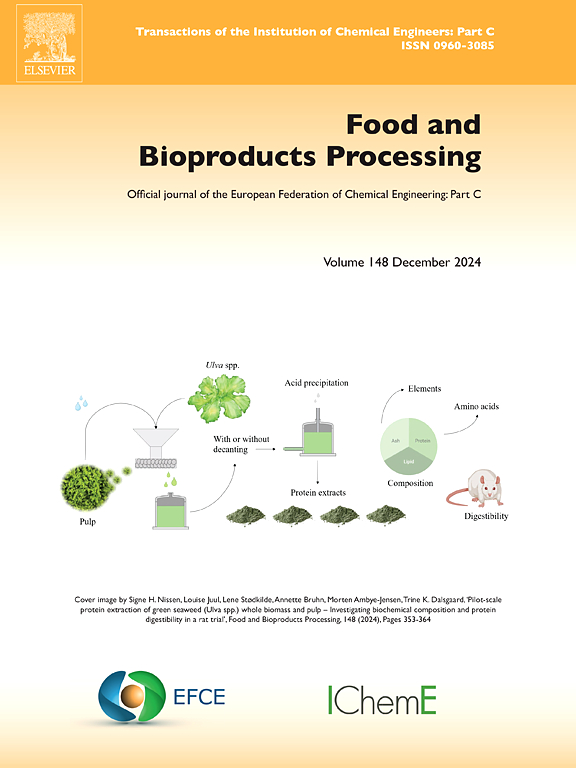An approach to subcritical fluid and natural deep eutectic solvent-ultrasound assisted extractions as green alternatives for Pecan nutshell phenolic compounds recovery
IF 3.5
2区 农林科学
Q2 BIOTECHNOLOGY & APPLIED MICROBIOLOGY
引用次数: 0
Abstract
Green alternatives for Pecan nutshell phenolic compounds recovery were assessed in the present work. Subcritical fluid extraction and ultrasound-assisted extraction with natural deep eutectic solvent were optimized to maximize phenolic compounds extraction and antioxidant activities. Subcritical fluid was analyzed by varying temperature (180–220°C), flow rate (2.5–7.5 g/min) and solvent composition (0–100 % (v/v) ethanol/water mixtures). The optimal Subcritical fluid method involved operating at 220°C with 50 % (v/v) ethanol/water at a flow rate of 5 g/min, resulting in a remarkable 200 % increase on total phenolic compounds and a substantial 500 % increase on antioxidant activity measured by ferric reducing ability of plasma when compared to stirring, a conventional method used as control. Moreover, several ultrasound-assisted extractions with natural deep eutectic solvent were produced with choline chloride and lactic or malic acids; after selecting choline chloride-malic acid, the ratio and water % were optimized through response surface methodology. The optimal ultrasound-assisted extraction with natural deep eutectic solvent employed a 1:1 mol:mol ratio, with a water content of 35.82 % (v/v), yielding a 39 % and 25 % increase on total phenolic compounds and ferric reducing ability of plasma compared to stirring, respectively. Finally, a full evaluation of the most relevant characteristics regarding process, estimation of equipment and extraction costs and a comparison regarding simplicity, safety, selectivity, cost vs. benefit and applicability among the employed methods was included. This research contributes to the development of environmentally friendly technologies and its advantages/drawbacks applied to phenolic compounds recovery from Pecan nutshell with potential applications in food, cosmetics and pharmaceutical industries.
亚临界流体和天然深共晶溶剂-超声辅助提取山核桃果壳酚类化合物的绿色方法研究
对山核桃酚类化合物的绿色回收方法进行了评价。对亚临界流体萃取法和超声波辅助萃取法进行了优化,以最大限度地提高酚类化合物的提取率和抗氧化活性。亚临界流体通过改变温度(180-220°C)、流速(2.5-7.5 g/min)和溶剂组成(0-100 % (v/v)乙醇/水混合物)进行分析。最佳的亚临界流体方法是在220°C下,以50 % (v/v)乙醇/水,5 g/min的流速进行操作,与传统的搅拌方法相比,总酚类化合物显著增加200 %,通过测定血浆的铁还原能力,抗氧化活性显著提高500 %。此外,以氯化胆碱和乳酸或苹果酸为溶剂,制备了几种天然深共晶溶剂的超声辅助萃取物;选择氯胆碱-苹果酸后,通过响应面法对其配比和含水率进行优化。天然深共晶溶剂超声辅助提取的最佳条件为: mol:mol比为1:1,水含量为35.82 % (v/v),与搅拌相比,等离子体总酚类化合物和铁还原能力分别提高了39 %和25 %。最后,对工艺、设备和提取成本的最相关特征进行了全面评估,并对所采用方法的简单性、安全性、选择性、成本效益和适用性进行了比较。本研究为开发山核桃果壳中酚类化合物的环保回收技术及其优缺点提供了参考,在食品、化妆品和制药等行业具有潜在的应用前景。
本文章由计算机程序翻译,如有差异,请以英文原文为准。
求助全文
约1分钟内获得全文
求助全文
来源期刊

Food and Bioproducts Processing
工程技术-工程:化工
CiteScore
9.70
自引率
4.30%
发文量
115
审稿时长
24 days
期刊介绍:
Official Journal of the European Federation of Chemical Engineering:
Part C
FBP aims to be the principal international journal for publication of high quality, original papers in the branches of engineering and science dedicated to the safe processing of biological products. It is the only journal to exploit the synergy between biotechnology, bioprocessing and food engineering.
Papers showing how research results can be used in engineering design, and accounts of experimental or theoretical research work bringing new perspectives to established principles, highlighting unsolved problems or indicating directions for future research, are particularly welcome. Contributions that deal with new developments in equipment or processes and that can be given quantitative expression are encouraged. The journal is especially interested in papers that extend the boundaries of food and bioproducts processing.
The journal has a strong emphasis on the interface between engineering and food or bioproducts. Papers that are not likely to be published are those:
• Primarily concerned with food formulation
• That use experimental design techniques to obtain response surfaces but gain little insight from them
• That are empirical and ignore established mechanistic models, e.g., empirical drying curves
• That are primarily concerned about sensory evaluation and colour
• Concern the extraction, encapsulation and/or antioxidant activity of a specific biological material without providing insight that could be applied to a similar but different material,
• Containing only chemical analyses of biological materials.
 求助内容:
求助内容: 应助结果提醒方式:
应助结果提醒方式:


